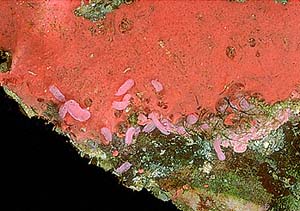
Population fluctuations
PHOTO
Part of a large population of Noumea haliclona on its food sponge Darwinella. Mallacoota, northern Victoria, February 1983
PHOTO: Bill Rudman.
At times we see huge numbers of a particular species and then other times there will be none. In other cases common species at a particular spot will disappear for months or even years. Without long term studies of each individual species it is difficult to come up with "general rules" for phenomena such as these. The causes of such population fluctuations, both explosions and declines, are often difficult to determine. The most common and most spectacular examples, probably because they are intertidal and relatively large, concern Sea Hares. Often they are found on beaches packed so thickly that one is forced to walk on the animals to get past [see Mass Mortality].
When we find large sea slugs, mating or laying eggs, then disappearing, it is reasonable to think that the animals have "migrated" to the egg-laying spot then moved away. This type of interpretation has led to many accounts of "breeding migrations" which on further study have been shown to be open to a much more simple explanation. Most sea slugs, being specialist feeders, live where their food is found. In many cases they will settle out of the plankton directly on to a colony of their food, or in the case of herbivores, on to a food plant or place where the plant they feed on is abundant. Since they can grow remarkably quickly if food is abundant, the apparent sudden appearance of a large population of a species may be the result of the rapid growth of juveniles on abundant food rather then the migration of animals from one part of the shore to another. Sea Slugs are hermaphrodite, with a full complement of male and female organs. When they are mature they regularly mate with any available partner. Large aggregations of mating animals are often called "mating aggregations" but we must be careful to realise that this is not a planned "orgy" but the result of their feeding behaviour leading to an aggregation of animals, which in turn leads to mating.
Often population crashes are the result of environmental catastrophes. Here are a couple of examples involving the small chromodorid, Noumea haliclona. In New South Wales it feeds on pink and a yellow forms? [or species?] of the sponge Darwinella. It is often common intertidally in Sydney Harbour, feeding on a yellow Darwinella, but at other times there are none to be seen. In the 1980s, the Sydney Harbour intertidal population of this species was wiped out for over a year by a severe storm which occurred after 2 years of little rainfall. This storm caused huge quantities of freshwater to flow into the harbour turning the top layer of water almost fresh, and killed all the sponge colonies in the intertidal and in the top half metre of the subtidal. On another occasion, in northern Victoria, I found a population of millions of animals all feeding on a pink intertidal form of Darwinella (see photo). In this case severe storms washed all the intertidal sponge away in 2 nights and even a year later the intertidal population had not recovered. I guess the important lesson is that there is no general rule about such things. We need to study species, and perhaps populations, individually, as each will have its own needs and capabilities.
We also need to have an understanding of local conditions. The New South Wales coast, in eastern Australia, is essentially warm temperate , but at times there is a very tropical element in the flora and fauna, as warm water currents, flowing from the tropical north, carry larvae of tropical species down the coast. For opisthobranch larvae to settle and survive they need to find their preferred food organisms, which means that sometime earlier the larvae of their food would have needed to drift south as well. To understanding life histories and population survival therefore, we have to understand not just the life cycle and biology of one species, but the life cycle and biology of its food, its predators and many physical aspects of the environment.
• See Mass Mortality
• See Onchidoris bilamellata [#10454]
Rudman, W.B., 2004 (August 2) Population fluctuations. [In] Sea Slug Forum. Australian Museum, Sydney. Available from http://www.seaslugforum.net/factsheet/popfluc
Related messages
-
Opisthobranchs as bio-indicator species
From: Kira Alleyne, February 8, 2006 -
Population decline - Port Stephens
From: David & Leanne Atkinson, April 22, 1998 -
Population fluctuations
From: Kirsten Benkendorff, April 13, 1998
